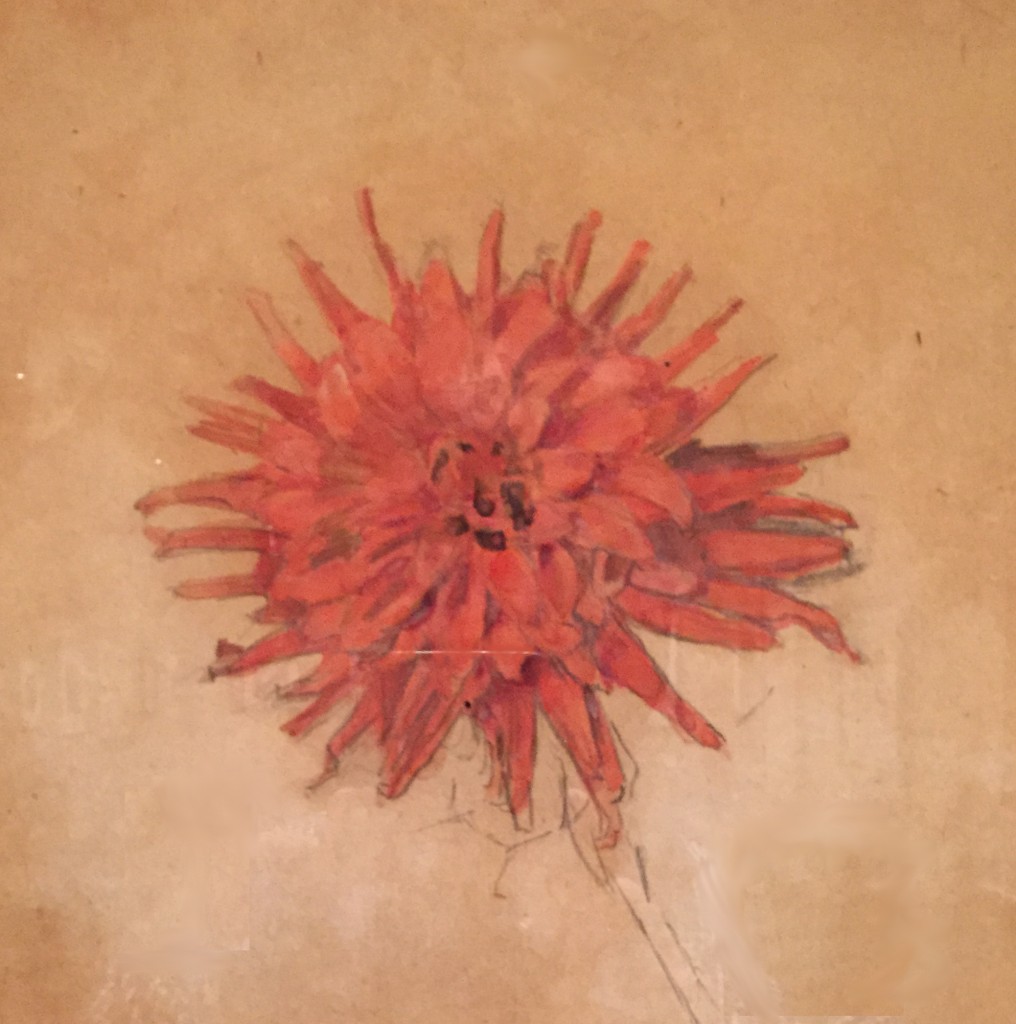Mondrian’s dahlias

Piet Mondrian, Red Dahlia, 1907, (detail), Opaque and transparent watercolor over graphite on paper. 12 7/16 x 9 7/8 inches Morgan Library
I discovered this watercolor of a dahlia by Piet Mondrian in the Morgan Library’s current retrospective of Emmet Gowin’s photography, a small show that was both astonishing and humbling when I ducked in to see it on my way to JFK on Friday. It’s so great I almost didn’t want to sully it with words, though I’m sure I will soon. Instead, I wanted to stay and study it for a few days, make myself at home, but I had that late flight back to Rochester at Terminal 5. The catalog lists everything on exhibit, but doesn’t offer images of more than a fourth or a third of it, and I was disappointed not to be able to revisit, in the catalog, many of the startling and powerful pieces, reaching back centuries, from the Morgan’s vault that Gowin chose to include in the exhibit. Since I’ve been growing dahlias for nearly a decade and painted many of them, this little revelation surprised and pleased me, especially since it’s so well done, but also because it demonstrated how artists can’t really stick to one thing for long, and how polarities can energize their work.
I had no idea that, while he was realizing his identity in his famous primary-colored grids, Mondrian continued to draw flowers, work that represented the exact opposite of his oils, in formal terms. Nothing could be further from Mondrian’s career-making grids than this dahlia, yet maybe these flowers are precisely what sustained his investigation of the spare music he found in rectangles and squares. (Frederick Hammersley’s dialectic of working in both geometric and organic shapes comes to mind.) Gowin shifted gears a number of times himself and was intensely absorbed by opposing, contrary states: light and dark, harrowing desolation and domestic rapture, butterflies from the rain forest and craters from the wastelands of nuclear testing. I will save for a future post what he communicated to me with these images toggling between garden and gehenna (to adopt the Biblical mythology Gowin absorbed young and then deployed as a foundation for his mature artistic vision and for this show.) His deep immersion in William Blake’s writing and visual art is what drew me to the show, and he’s a worthy heir to Blake in his own photography, an earlier genius who drew from Gnosticism as the foundation for a deeply original vision. Two of Blake’s best, from his illustrations for the Book of Job–both of which I saw previously, in an earlier show at the Morgan–are included alongside Gowin’s photographs.
Gowin is a great soul, and this exhibit is a profound experience, a major discovery of the breadth and depth of his sensibility, and it’s impossible to do justice to it in a blog post. But maybe, if I can respond to this show the way I’d like in a little while, I can encourage a few to see what he’s done, because of the quality of work Gowin produced himself, but also because everything in the show appears fresh and new in the context of this photographer’s long and slow curatorial excavation of art from the Morgan’s permanent collection to pair with his own photography. As the curator of this show, Gowin has put together a visionary work of art itself–everything you see feels as if you’re glimpsing something for the first time. More often than not, it was literally my first look at the work. I felt regret simply pulling myself away from one image hanging on the wall in order to see what was mounted next to it. With the time available to me after a day’s working visit to the city, I picked the one exhibit that could not have been equaled (in the artist’s reverence, awe, decency and quiet authority) by anything else on view in New York City right now. Apparently, my luck continues to hold. And so does my mournful hope that quiet, deeply humble art, grounded in genuine wisdom and an affirmation of all human experience, can prevail. Gowin is a sage. Joseph Campbell would have loved this show.
Comments are currently closed.